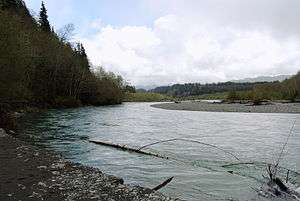Hoh Rainforest
The Hoh Rainforest is located on the Olympic Peninsula in western Washington state, USA. It is one of the largest temperate rainforests in the U.S.[1] Within Olympic National Park, the forest is protected from commercial exploitation. This includes 24 miles (39 km) of low elevation forest 394 to 2,493 feet (120 to 760 m) along the Hoh River. The Hoh River valley was formed thousands of years ago by glaciers. Between the park boundary and the Pacific Ocean, 48 km (30 mi) of river, much of the forest has been logged within the last century, although many pockets of forest remain.

Climate
| Climate data for Hoh Ranger Station, Olympic National Park, Washington | |||||||||||||
|---|---|---|---|---|---|---|---|---|---|---|---|---|---|
| Month | Jan | Feb | Mar | Apr | May | Jun | Jul | Aug | Sep | Oct | Nov | Dec | Year |
| Record high °F (°C) | 54 (12) |
62 (17) |
69 (21) |
86 (30) |
87 (31) |
93 (34) |
94 (34) |
93 (34) |
88 (31) |
71 (22) |
58 (14) |
53 (12) |
94 (34) |
| Average high °F (°C) | 40.8 (4.9) |
44.3 (6.8) |
47.1 (8.4) |
54.8 (12.7) |
61.1 (16.2) |
63.9 (17.7) |
71.6 (22) |
71.5 (21.9) |
66.6 (19.2) |
55.2 (12.9) |
46.3 (7.9) |
40.2 (4.6) |
55.28 (12.93) |
| Average low °F (°C) | 33.5 (0.8) |
33.0 (0.6) |
34.0 (1.1) |
37.1 (2.8) |
42.6 (5.9) |
47.4 (8.6) |
50.7 (10.4) |
51.2 (10.7) |
47.4 (8.6) |
41.2 (5.1) |
36.0 (2.2) |
32.7 (0.4) |
40.57 (4.77) |
| Record low °F (°C) | 17 (−8) |
20 (−7) |
24 (−4) |
28 (−2) |
32 (0) |
37 (3) |
43 (6) |
42 (6) |
37 (3) |
27 (−3) |
18 (−8) |
17 (−8) |
17 (−8) |
| Average precipitation inches (mm) | 24.86 (631.4) |
11.70 (297.2) |
14.45 (367) |
10.27 (260.9) |
5.80 (147.3) |
3.72 (94.5) |
2.23 (56.6) |
3.14 (79.8) |
6.37 (161.8) |
10.12 (257) |
20.88 (530.4) |
14.27 (362.5) |
127.81 (3,246.4) |
| Average snowfall inches (cm) | 7.7 (19.6) |
7.6 (19.3) |
2.7 (6.9) |
0.7 (1.8) |
0.0 (0) |
0.0 (0) |
0.0 (0) |
0.0 (0) |
0.0 (0) |
0.0 (0) |
2.3 (5.8) |
6.5 (16.5) |
27.5 (69.9) |
| Source: [2] | |||||||||||||
Flora


The dominant species in the rainforest are Sitka spruce (Picea sitchensis) and western hemlock (Tsuga heterophylla); some grow to tremendous size, reaching 95 metres (312 ft) in height and 7 metres (23 ft) in diameter. Coast Douglas-fir (Pseudotsuga menziesii var. menziesii), western redcedar (Thuja plicata), bigleaf maple (Acer macrophyllum), red alder (Alnus rubra), vine maple (Acer circinatum), and black cottonwood (Populus trichocarpa) are also found throughout the forest.
Many unique mosses and lichens are also present in the rainforest, such as lettuce lichen (Lobaria oregana), which "requires the cool, moist conditions found under the canopy of old-growth forests" and is consumed by deer, elk, and other animals.[3]
Fauna
Many native fauna also make the Hoh Rainforest their home, including the Pacific tree frog (Pseudacris regilla), northern spotted owl (Strix occidentalis caurina), bobcat (Lynx rufus), cougar (Felis concolor couguar), raccoon (Procyon lotor), Olympic black bear (Ursus americanus altifrontalis), Roosevelt elk (Cervus canadensis roosevelti), and black-tailed deer (Odocoileus columbianus).
The area is also home to the banana slug (Ariolimax columbianus), which has recently been threatened by the encroachment of a new species of slug, the black slug (Arion ater), an invasive species from Northern Europe.[4]
Sights

The Hoh Rainforest is home to a National Park Service ranger station, from which backcountry trails extend deeper into the national park.
Near the visitor center is the Hall of Mosses Trail, a short trail—0.8 miles (1.3 km)—which gives visitors a feel for the local ecosystem and views of maples draped with large growths of spikemoss. There is also the Spruce Nature Trail (1.2 miles (1.9 km)), which includes signs that identify various trailside trees and plants.
Gallery
- See also
 Media related to Hoh Rainforest at Wikimedia Commons
Media related to Hoh Rainforest at Wikimedia Commons
 The Hoh River that runs through the forest.
The Hoh River that runs through the forest.- A herd of elk grazing at the forest.
 A banana slug.
A banana slug.- A nurse log providing nutrients for other growing trees.
In Popular Culture
- The novel The Other (2008) by David Guterson centers on a young man who chooses to live in isolation in the Hoh Rainforest, and who comes to be known as "The Hermit of the Hoh."
- The Hoh Rainforest is the setting for the National Geographic Channel reality television series The Legend of Mick Dodge.
References
- ↑ "Visiting the Hoh Rain Forest". Olympic National Park. National Park Service.
- ↑ "HOH RS, WASHINGTON (453710)". Western Regional Climate Center. Retrieved June 6, 2016.
- ↑ Bolen, E.G. (1998). Ecology of North America. John Wiley & Sons. p. 346. ISBN 0-471-13156-3.
- ↑ Cowie R. H., Dillon R. T., Robinson D. G. & Smith J. W. (2009). "Alien non-marine snails and slugs of priority quarantine importance in the United States: A preliminary risk assessment". American Malacological Bulletin 27: 113–132. PDF.
External links
- Hoh Rainforest at the National Park Service
- The Hoh River Trust, founded by the Wild Salmon Center and the Western Rivers Conservancy
Coordinates: 47°51′41.2″N 123°55′28.8″W / 47.861444°N 123.924667°W